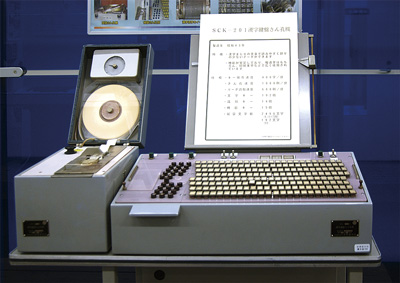

- Home >
- Artifacts of IP Heritage >
- 2009 >
- SCK-201 Kanji Teleprinter with keyboard and paper tape punching machine
SCK-201 Kanji Teleprinter with keyboard and paper tape punching machine

| Manufactured in | 1968 |
|---|---|
| Manufactured by | Shinko MechatroTech Co., Ltd. |
| Owner | Shinko MechatroTech Co., Ltd. |
| Location of historical materials | Shinko MechatroTech Co., Ltd. 9-92-6 Ohata, Hanamaki, Iwate 025-0354 Japan |
| Visitor information | Open to the public (Reservation required) |
| Contact | General Affairs & personnel section, Administration Department, Shinko MechatroTech Co., Ltd. Tel.+81-198-26-4311 |
In 1955, Shinko MechatroTech Co., Ltd. developed a kanji telerprinter jointly with Asahi Shinbum Company to achieve transmission and printing of Japanese messages combining kanji and kana. Based on this prototype and the result, Shinko manufactured SC4-24, the Kanji Teleprinter with keyboard and paper tape punching machine, and SC4-11 Kanji Teleprinter/Translator in 1958, which were the first machine in Japan. This contributed greatly to mechanization and improvement of information transmission speed among the news media, and as the result, the Kanji Teleprinter became widespread among newspaper companies.
Shinko's kanji teleprinters were introduced to the systems for NTT and KDD, which were used in 1964 Tokyo Olympic Games. In 1967 Shinko developed SCK-100, a portable kanji keyboard and they were used to report the news of the Mexico Olympic Games and Apollo's landing on the Moon. These experiences lead to the development of SCK-201, a portable kanji teleprinter with keyboard and paper tape punching machine in 1968. Japanese sentences with kanji and kana were input by the multi-shift keyboard, and the teleprinter output the data with punched holes on a paper tape. One unit of this product is displayed in Shinko's showroom in well-preserved condition. Shinko also developed SCK200F, a kanji input device controlled by a microcomputer around 1975.
The kanji teleprinter is the first machine to realize the input/output of kanji by multi-shift keyboard system. It therefore played a significant role as Japanese input/output processing device and regarded as a forerunner of Japanese word processers of later time.
